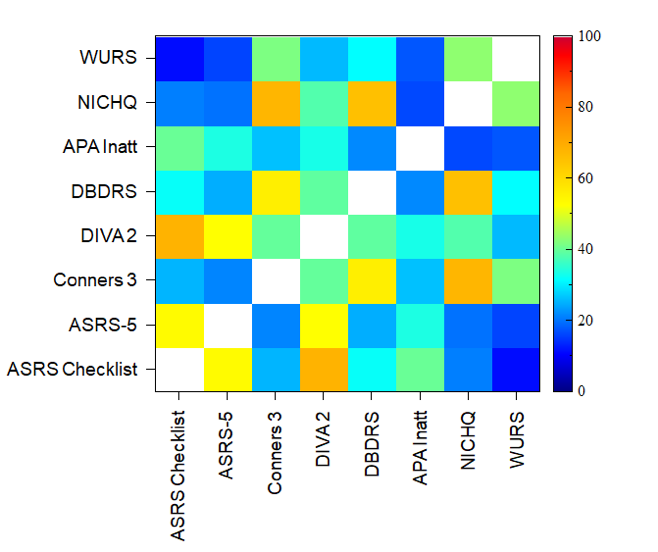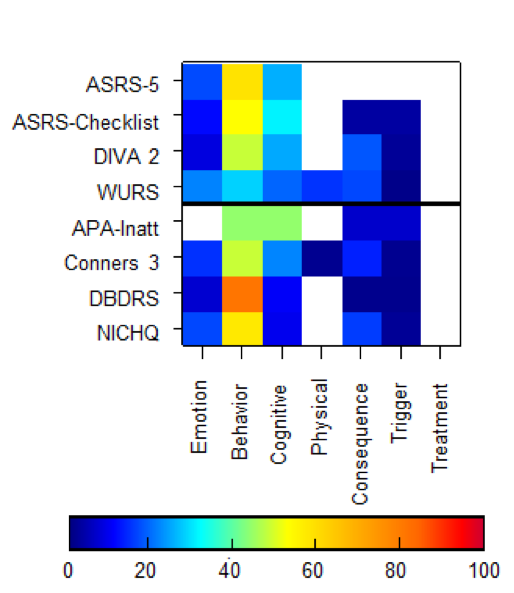Assessment of ADHD differs substantially between tools meant for children and adults with implications for discovery of biomarkers.
Across a series of recent posts we’ve been documenting the assessment of mental health disorders, revealing considerable inconsistency and ambiguity in their approach to symptom assessment both within and across disorders (see Quantitative Similarity of Depression Tools and The Ambiguous Symptoms of Autism and A Disorder Agnostic Approach to Mental Health Symptoms).
In this post we turn to ADHD to examine what the assessment landscape looks like for this particular disorder. ADHD is commonly associated with a myriad of cognitive and behavioral symptoms, most often in terms of problems with attention and concentration and/or hyperactivity and restlessness. However, because of similarities between some symptoms of ADHD and the spectrum of normal human behavior, diagnosis of ADHD can sometimes be challenging (see Diagnosing Childhood ADHD).
ADHD assessment tools
To explore the way that ADHD is assessed during both childhood and adulthood, we examined 8 assessment tools (4 pediatric, 4 adult – see table below) and analyzed and compared the symptoms they asked about, and the way they asked about these symptoms. This analysis was done as part of a wider project looking across 9 different mental health disorders which reviewed 112 different assessment tools in total.
| Pediatric | Adult |
| APA Inattention Emerging Measures (APA Inatt) | WHO ADHD Self-Report Screening Scale for DSM-5 (ASRS-5) |
| Conners-3rd EditionTM (Conners 3) | Adult ADHD Self-Report Scale Symptom Checklist (ASRS-Checklist) |
| Disruptive Behavior Disorders Rating Scale (DBDRS) | Diagnostic Interview for ADHD 2.0 (DIVA 2) |
| NICHQ Vanderbilt Assessment Scale (NICHQ) | Wender Utah Rating Scale (WURS) |
Breadth and similarity of tools
Our analysis of these 112 tools had revealed 43 core symptoms which reflected the breadth of reported symptoms across these 9 mental health disorders. When we looked at how many of these symptoms were included in assessments of ADHD – i.e. are ADHD assessments very specific to a particular disorder profile, or do they also provide insights into the wider mental health profile of the individual – we found that, across all tools, the ADHD assessment tools asked about ~67% of these symptoms. However, only 21% of these (i.e. 6 symptoms out of 43) were asked about by 80% or more of the assessment tools. As might be expected for a disorder like ADHD, these symptoms related to problems with attention, concentration & mental focus; decision-making, risk taking & planning; restlessness & impatience; inhibition & impulsivity; interpersonal issues and interest, effort & motivation. So although there is a core set of symptoms which are consistently asked about across nearly all tools, there is also considerable variability in what other symptoms are assessed beyond this.
When we look at an analysis of the similarity between ADHD assessment tools we can see how this plays out when comparing individual tools. Across the 4 pediatric tools, 3 are relatively similar to each other in terms of the symptoms they ask about (e.g. Conners3, NICHQ and DBDRS) while within the adult tools, and between the pediatric and adult tools, there is considerably greater dissimilarity, resulting in a similarity score of only 35% across all ADHD assessment tools.
 A bias towards behavior
A bias towards behavior
Another aspect of ADHD assessment that emerges from our analysis is that symptom assessment questions predominantly focus on the behavior of the child or adult. Although you might expect such an approach to be common for childhood ADHD, where it is usually the parent that completes the assessment based on their observations of the child, this pattern also holds for adult ADHD assessments, suggesting it isn’t just a byproduct of a parent-based approach.
But what’s apparent (with one or two exceptions) is that there is relatively little focus on emotional, cognitive or physical symptoms experienced by the individual. And although ADHD might be considered first and foremost a behavioral disorder, so justifying a lesser emphasis on other types of symptoms, this bias does also raise the question as to whether it results in other important symptoms (e.g. emotional ones) which may co-manifest with these behavioral ones, being overlooked or downplayed.
 What’s more, this highly variable mental health profile makes it challenging to identify biomarkers of ADHD, such as those using resting-state EEG (see ADHD and the Theta/Beta Ratio), especially in the case where the metrics of ADHD symptom severity are based on indirect parental observations of the patient’s behavior.
What’s more, this highly variable mental health profile makes it challenging to identify biomarkers of ADHD, such as those using resting-state EEG (see ADHD and the Theta/Beta Ratio), especially in the case where the metrics of ADHD symptom severity are based on indirect parental observations of the patient’s behavior.
Understanding the borders of normality and abnormality
Within the schema of mental health, having an understanding of the border between mental health dysfunction and the spectrum of cognitive, emotional and behavioral functioning that presents itself within the general population is a clear challenge [e.g. 1] . However, only by having tools which provide a complete and unbiased perspective of mental health in both normal populations and in patients can we start to untangle where this distinction may lie. To help try and answer this question (as well as others), Sapien Labs has developed the Mental Health Quotient (MHQ), a tool which aims to provide an unbiased and comprehensive assessment of mental health and well-being in both the general population and in clinical patients. Take the assessment here.
Reference
[1] Wakefield, J.C. (2016). Diagnostic Issues and Controversies in DSM-5: Return of the False Positives Problem. Annual Review of Clinical Psychology 12(1), 105-132.

